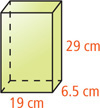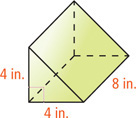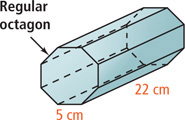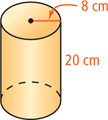 Practice and Problem-Solving Exercises
Practice and Problem-Solving Exercises
A Practice
See Problem 1.
Use a net to find the surface area of each prism.
-

-

-

-
- Classify the prism below.
- Find the lateral area of the prism.
- The bases are regular hexagons. Find the sum of their areas.
- Find the surface area of the prism.

See Problem 2.
Use formulas to find the surface area of each prism. Round your answer to the nearest whole number.
See Problem 3 and 4.
Find the lateral area of each cylinder to the nearest whole number.
Find the surface area of each cylinder in terms of
-

-

-

- Packaging A cylindrical carton of oatmeal with radius 3.5 in. is 9 in. tall. If all surfaces except the top are made of cardboard, how much cardboard is used to make the oatmeal carton? Assume no surfaces overlap. Round your answer to the nearest square inch.
Table of Contents
- 6-1 The Polygon Angle-Sum Theorems
- 6-2 Properties of Parallelograms
- 6-3 Proving That a Quadrilateral Is a Parallelogram
- 6-4 Properties of Rhombuses, Rectangles, and Squares
- 6-5 Conditions for Rhombuses, Rectangles, and Squares
- 6-6 Trapezoids and Kites
- 6-7 Polygons in the Coordinate Plane
- 6-8 and 6-9 Coordinate Geometry and Coordinate Proofs










